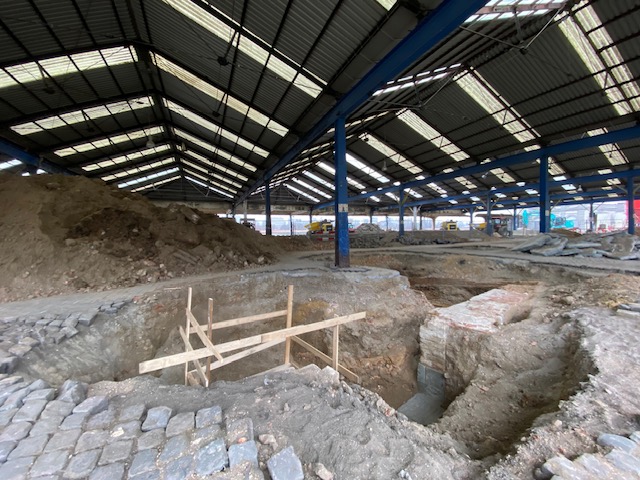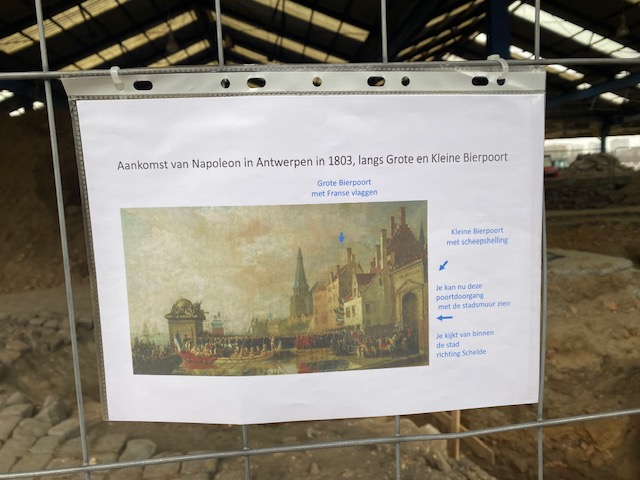In Antwerp, the Bierwerf mooring place under the Zuiderterras has surfaced. The Scheldt Quays are currently undergoing a major redevelopment. An ideal moment for city archaeologists to investigate the location and condition of the old city wall and the city gates Kleine and Grote Bierpoort.
On the site they found exceptionally well-preserved remains of the monumental passage of the Kleine Bierpoort and the connecting city wall. The walls and floors of a harbor house near the gate were also exposed.
The design process surrounding the integration of this piece of port heritage can now start, in the context of the Scheldt Quays Master Plan.
Following the reconstruction of the Scheldt Quays at the height of the roofs on the Zuiderterras, archaeologists have uncovered the remains of the city wall and the medieval mooring place Bierwerf. Viewing pits were dug for this purpose. The preliminary investigation serves to better understand the exact location, condition and structure.

Beer yard
The Bierwerf was located within the first city expansion of 1200, between the Rui and the Sint-Jansvliet, near the Haverstraat. This landing stage, also called Bierhoofd or Houten Hoofd, was one of the most important landing stages of the Antwerp roadstead, the place where the ships anchored. The name Houten Hoofd refers to the wooden quay wall.
Mayor Bart De Wever (N-VA) is also an avid historian: “The reconstruction of the Scheldt Quays offers an exceptional opportunity to bring the disappeared city remains back to light. The archaeological remains of the Bierkaai have great cultural-historical value as an iconic part of the old roadstead of Antwerp. The Bierwerf was part of port activity on the Scheldt for centuries. Antwerp was then an important economic and cultural center. Traditionally the beer was unloaded here by the beer ships. Due to the flourishing trade, the moorings were repeatedly enlarged and the gates were renewed. Due to the adjustments under the French occupation and the straightening of the Scheldt Quays at the end of the 19th century, the impressive facade and the well-known roadside view disappeared. The few remains of this are therefore an important last witness of the medieval quay line of Antwerp.”

Remains of the oldest city wall excavated
During the excavations, remains of the oldest city wall were uncovered, which connected to the Bakkerstoren on the Suikerrui. The wall was built in large blocks of Tournai limestone around the year 1300.
A corner pillar and the original paving in clay clinkers were installed at the Grote Bierpoort, the gate through which then-first consul Napoleon Bonaparte and his entourage made their solemn entry into Antwerp in 1803.
The Kleine Bierpoort has been found in very good condition. There, city archaeologists found monumental remains of the 16th-century city wall and the Renaissance gate. Even the holes of the gate lock are still visible in the sill of the gate.
Walls and floors of the harbor houses that were built against the city wall between the two Bierpoorten were also found. The house near the Kleine Bierpoort provides an unexpected insight into daily life at the mooring with the discovery of a fireplace with Delft tiles.



Integration into the design of Scheldt Quays
The archaeological remains were cleaned up, measured and documented as best as possible. The detailed information will be provided to the design team of the Scheldt quays. The monumental remains of the city walls and gates form a unique harbor ensemble with a beautiful piece of history.
The Scheldt Quays Master Plan provides for the stabilization of the quay wall, the raising of the flood defense and the construction of new, attractive public space on the quay plain. Heritage and the city’s maritime past are one of the starting points when drawing up the new plans. The port history is present in the various subzones: in the north at Loodswezen, the canals will be reflected in the design as a structuring element, in the center the castle wall and the old street pattern will be made visible under the canopies of the Noorderterras, and to the south the Sint-Michielsbastion or St. Michael’s Bastion realized as an open-air site.
Alderman for Urban Development and the Harbour Annick De Ridder (N-VA): “Within the context of the redevelopment of the 7 kilometer long Scheldt quays, city archaeologists are conducting research at the Zuiderterras. The port’s history runs like a common thread through the various subzones of the Scheldt quays. This is also the case here, where remains of the medieval mooring place Bierwerf have been found. It is here that Napoleon first set foot in Antwerp in 1803. He eventually turned Antwerp into a truly modern port and had the very first harbor dock built there. It is now up to the design team to examine whether and how the archaeological finds of city walls and gates could be incorporated into the design of this part of the quay plain.”
You want to know more? Go to www.archeologiescheldekaaien.be.

4 Comments Add yours